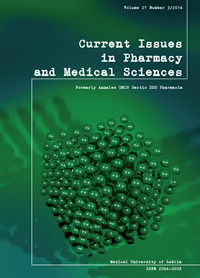Identificatin and quantiative analysis of amyrins in Humulus lupulus L.
DOI:
https://doi.org/10.1515/cipms-2015-0002Keywords:
amyrin, triterpenes, Humulus lupulusAbstract
In the paper, the identification and quantification of α- and β-amyrin in five varieties of Humulus lupulus is described. The plant samples were extracted with ethyl acetate and analyzed using of high performance liquid chromatography (HPLC) with PAD detection. The separation was achieved on RP 18 column, at 2 mL/min flow rate and at temperature of 35°C. Acetonitrile was used as a mobile phase. The established calibration curves and the other validation parameters: linearity (correlation coefficient r > 0.9988) and precision (RSD values ranged from 0.14 to 1.81%) were found to be satisfactory for the proposed method. The content of α- and β-amyrin strongly depended on varieties of H. lupulus and amounted from 72.7 to 232.5 µg/g and from 77.9 to 176.9 µg/g of dry plant material, respectively.
References
1. Chadwick L.R., Pauli G.F., Farnsworth N.R.: The pharmacognosy of Humulus lupulus L. (hops) with an emphasis on estrogenic properties. Phytomedicine 13, 119, 2006.
2. Colgate E.C. et al.: Xanthohumol, a prenylflavonoid derived from hops induces apoptosis and inhibits NF-kappaB activation in prostate epithelial cells. Cancer Letters 246, 201, 2007.
3. Gerhauser C.: Broad spectrum antiinfective potential of xanthohumol from hop (Humulus lupulus L.) in comparison with activities of other hop constituents and xanthohumol metabolites. Molecular Nutrition Food Research 49, 827, 2005.
4. Jabeen, K. et al. Antifungal compounds from Melia azederach leaves for management of Ascochyta rabiei, the cause of chickpea blight, Nat. Prod. Res., 25, 264, 2011.
5. Schiller H. et al.: Sedating effects of Humulus lupulus L. extracts. Phytomedicine 13, 535, 2006.
6. Trojak-Goluch A., Skomra U.: Artifically induced polyploidization in Humulus lupulus L. and its effect on morphological and chemical traits. Breeding Sci., 63, 393, 2013.
7. Van Cleemput M. et al.: Hop (Humulus lupulus)-derived bitter acids as multipotent bioactive compounds. J. Nat. Prod., 72, 1220, 2009.
8. Wang X. et al: In vitro and in vivo antioxidant and antimutagenic activities of polyphenols extracted from hops (Humulus lupulus L.). J Sci Food Agric., 94, 1693, 2014.
9. Wansi J. P. et al.: Antimicrobial and antioxidante effects of phenolic constituents from Klainedoxa gabonensis, Pharmaceutical Biology, 48, 1124, 2010.
10. Yu L. et al.: Novel prenylated bichalcone and chalcone from Humulus lupulus and their quinone reductase induction activities. Fitoterapia 93, 115, 2014.
11. Zanoli, P. et al.: Evidence that the acids fraction of hops reduces central GABAergic neurotransmission. J. Ethnopharmacol. 109, 87, 2007.
12. Zanoli P., Zavatti M.: Pharmacognostic and pharmacological profile of Humulus lupulus L. J. Ethnopharmacol. 116, 383, 2008.
13. Zheng, Y. et al.: Antibacterial compounds from Siraitia grasvenorii leaves, Nat. Prod. Res., 25, 890, 2011.s and perspectives of Bacillus bacteria as probiotics. J. Prob. Health., 1, 1000e106, 2013. (doi: 10.4172/2329-8901.1000e106)
Downloads
Published
Issue
Section
License
Copyright (c) 2015 Authors

This work is licensed under a Creative Commons Attribution-NonCommercial-NoDerivatives 3.0 Unported License.


